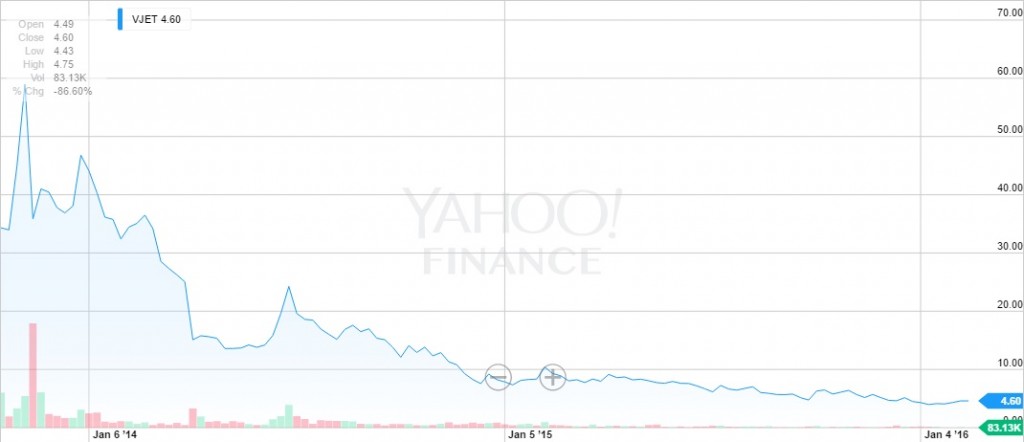Among the listed 3D printing companies, voxeljet (NYSE: VJET) is a very different animal from 3D Systems (DDD) and Stratasys (SSYS). First, it’s a much smaller player with a tight range of industrial 3D printers for the production of molds and models for metal casting without tooling. Second, it is a German-based manufacturer with 80% of its sales coming from Europe. Third, the company is still lead by one of its founders. Fourth, in 2015, voxeljet managed to record sales in line with its original forecast. And fifth, voxeljet grew significantly in 2015 with revenue up nearly 50% from 2014, a sharp contrast from the zero growth booked at Stratasys and 3D Systems in 2015.
Nevertheless, voxeljet’s share price has collapsed since its peak in late 2013, leaving a market capitalisation near book value. This should drive interest from possible suitors.

An impressive growth in the last 5 years
Voxeljet was founded in 1999. In 2010, annual sales were at €5M, with a 43% gross margin. Since then, sales have increased five-fold, to reach €24M in 2015. This growth demonstrates the quality of the products manufactured by the company and its capacity to render services associated with the machines.
|
€M |
2010 | 2013 | 2014 | 2015 (e) |
| Sales | 5m | 11m | 16m |
24m |
The CEO is a founder and the main shareholder
Contrary to Stratasys and 3D Systems, voxeljet is lead by its founder and main shareholder, Ingo Ederer. With Rudolf Franz, an early investor in voxeljet, they own nearly a quarter of the company. They bring stability and leadership at an important time for the 3D printing market and the company. Following the IPO in November 2013, Ingo Ederer remained focused on voxeljet’s core market, using the $65M raised essentially to structure the business and invest in research and development.

A sound balance sheet
voxeljet had cash of €33M at the end of 2015 and practically no financial debt. With nearly no intangible assets and a net equity of €64M, the balance sheet is clear and easy to understand. It depicts a company very much focused on its business plan: to grow its sales organically and reach profitability as soon as possible.
voxeljet: what next?
On the 2nd of February 2016, voxeljet issued its financial guidance for 2016. It’s worth noting that the company did reach its ambitious 2015 target. Now, they forecast sales at between €28M and €30M for 2016, an increase of over 20% from 2015, even though 2015 numbers include voxeljet UK which are not included in 2016, following the decision to sell back this subsidiary. The company expects to reach a good 40% gross margin. This will bring voxeljet to EBITDA break even, a significant milestone. With investment expected in the €12-13M range, net cash at end 2016 is forecast at €20M.
Assuming Voxeljet achieves its 2016 goal, the company will have built the foundation for further growth. €20M might look like too little to bring them to the €100M revenue mark; therefore, Ingo Ederer could be willing to raise further cash in 2016 to keep growing the company. Considering the significant volatility on the stock market, the CEO would probably try to find an industrial partner or to merge with another 3D printing manufacturer.



